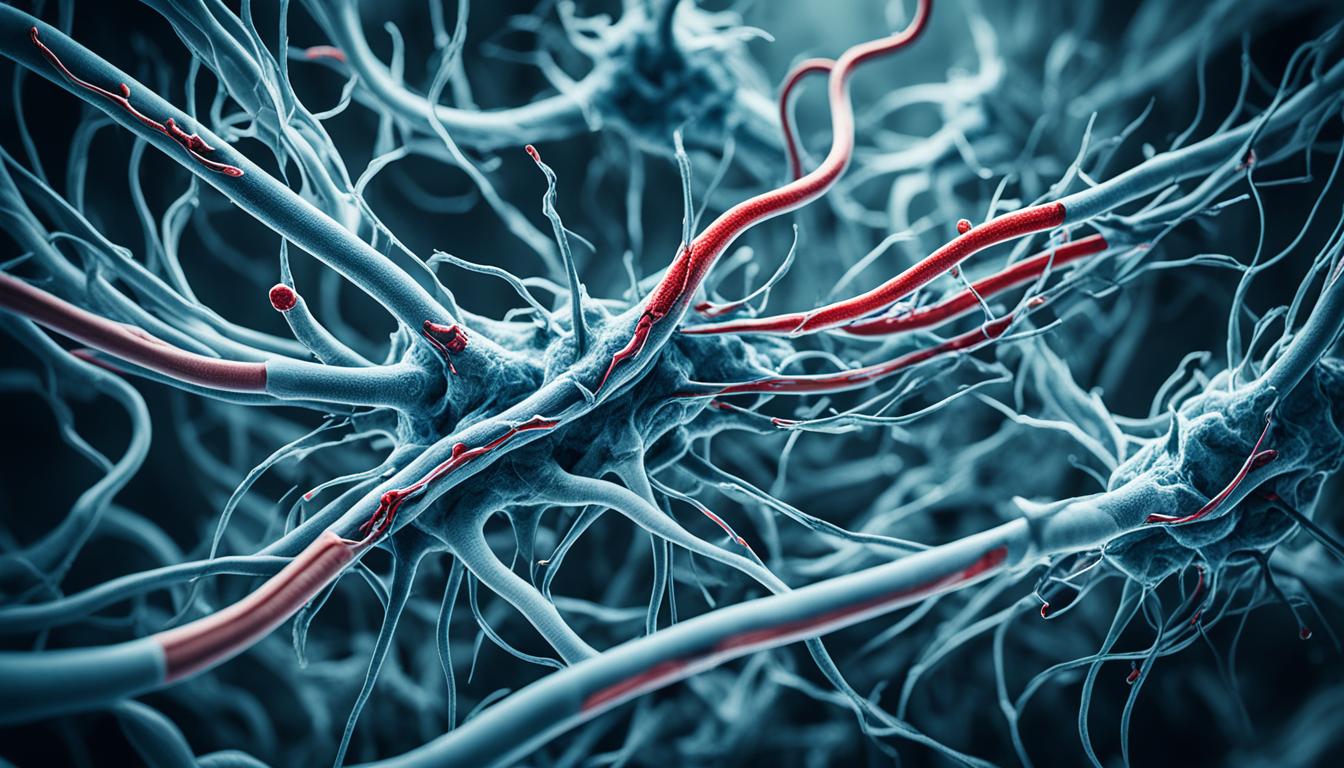Kawasaki disease mainly affects kids under five and causes a high fever. They also get a red skin rash, eyes that are red and swollen, and have a swollen tongue. Without treatment, it can lead to serious heart issues.
No one knows the exact cause, but doctors think it starts as the body fights an infection. To diagnose it, doctors look at the symptoms and do a heart test called echocardiography. The main treatments are fluids through a vein and aspirin. They are used to lower inflammation and stop heart problems. Scientists are looking into how stem cells could help, but more studies are needed.
Key Takeaways:
- Kawasaki disease is a pediatric vasculitis that primarily affects children under the age of five.
- Its symptoms include a long-lasting fever, a rash, and swollen parts like lips and limbs
- If not treated, the disease can cause dangerous heart issues.
- Doctors use tests like echocardiography to diagnose it.
- Treatments involve fluids through the vein and aspirin to protect the heart.
- Scientists are exploring the use of stem cell therapy, but more study is required.
Clinical Features and Diagnosis Criteria Comparison of Kawasaki Disease
Kawasaki disease mainly affects children. It triggers symptoms that are important to spot early. Knowing its signs and tests helps doctors diagnose it fast. This early diagnosis is key to starting treatment and avoiding further issues.
The clear signs include:
- High fever lasting for at least five days
- Red and swollen eyes
- Changes in the oral mucosa
- A rash
- Swollen lymph nodes
These clear symptoms help doctors pinpoint the disease. There are also smaller symptoms like joint pain, tummy troubles, fussiness, and tiredness. This mix of signs guides doctors in their diagnosis.
Diagnosing involves looking for several symptoms as well as following specific guidelines. The American Heart Association set these rules. They state that a child must have at least four major symptoms to be diagnosed. It’s also good to remember that rules can vary by country.
Early diagnosis is crucial to avoid heart problems. After diagnosis, regular check-ups are needed. These visits are for tracking the disease and possible complications. A heart ultrasound can pick up on issues early.
Image related to Kawasaki disease symptoms
Visually identifying Kawasaki disease symptoms is helpful. This image shows common signs like a rash, eye redness, and changes in the mouth. Recognizing these signs can lead to faster diagnosis and treatment.
Treatment of Kawasaki disease in children
Kawasaki disease is a serious illness in children. It needs quick action to lower their fever and prevent heart damage. Doctors often use a treatment plan with a special medicine called intravenous immunoglobulin (IVIG) and aspirin.
IVIG is key in reducing inflammation and stopping heart problems in kids with Kawasaki disease. It’s a medicine given through a vein that works to keep their heart healthy.
Aspirin, used alongside IVIG, helps to lower fever and make kids feel better. It fights inflammation, helping children recover from their illness.
After starting treatment, doctors keep a close eye on the child. They check how the treatment is working and handle any new symptoms or issues that may pop up.
If the child’s heart arteries face problems, more actions might be needed. Doctors then step in to try to stop these issues from causing big heart troubles.
Managing Kawasaki disease over time involves checking the heart often with tests like echocardiograms. Using medicine and making sure the child eats well and stays active are also big parts of keeping their heart strong.
Common Treatment Options for Kawasaki Disease
| Treatment | Description |
|---|---|
| Intravenous Immunoglobulin (IVIG) | Reduces inflammation and prevents coronary artery complications |
| Aspirin | Reduces fever and inflammation |
| Coronary Artery Interventions | Additional procedures to prevent further damage or blockage of the arteries |
| Regular Monitoring | Evaluation of treatment effectiveness and management of ongoing symptoms or complications |
| Long-term Management | Regular echocardiograms, medication, and lifestyle modifications to promote heart health |
Conclusion
Kawasaki disease mainly impacts young children. It’s vital for parents and doctors to understand its symptoms. They should act fast to get the child diagnosed and treated early. Ongoing research is looking into new treatment like stem cell therapy.
This research aims to improve our understanding and care for this disease. But, there’s still a lot more to learn about how well these treatments work and their effects over time.
By getting diagnosed early, the right treatment, and staying in touch with the doctor, a child’s recovery chances increase. This also lowers the chances of complications and keeps the child healthy. Thanks to ongoing research, we have hope for finding better care and outcomes for these kids.

